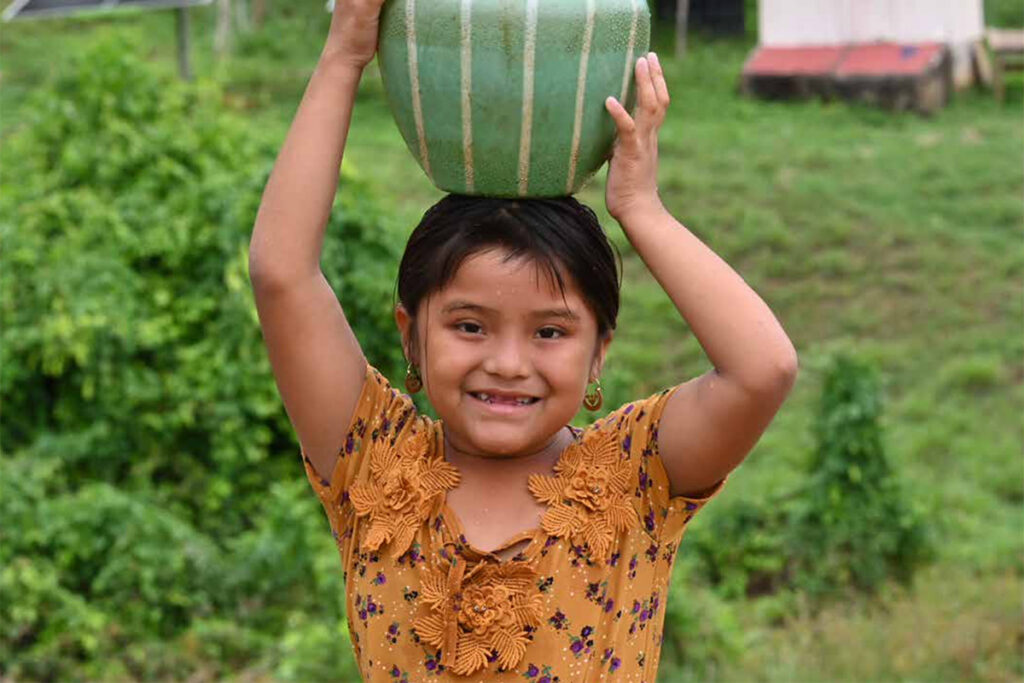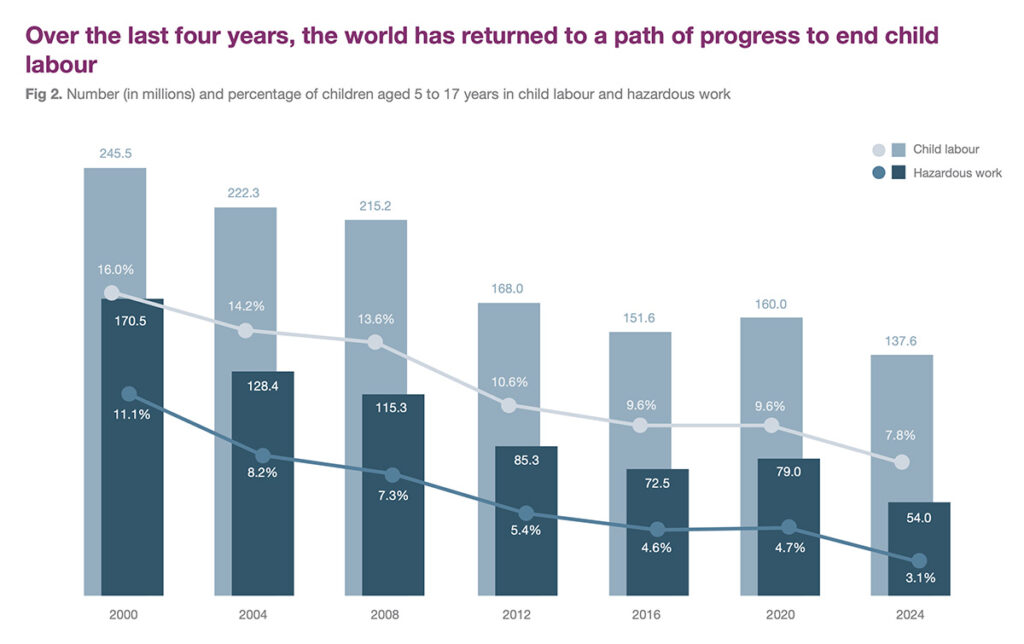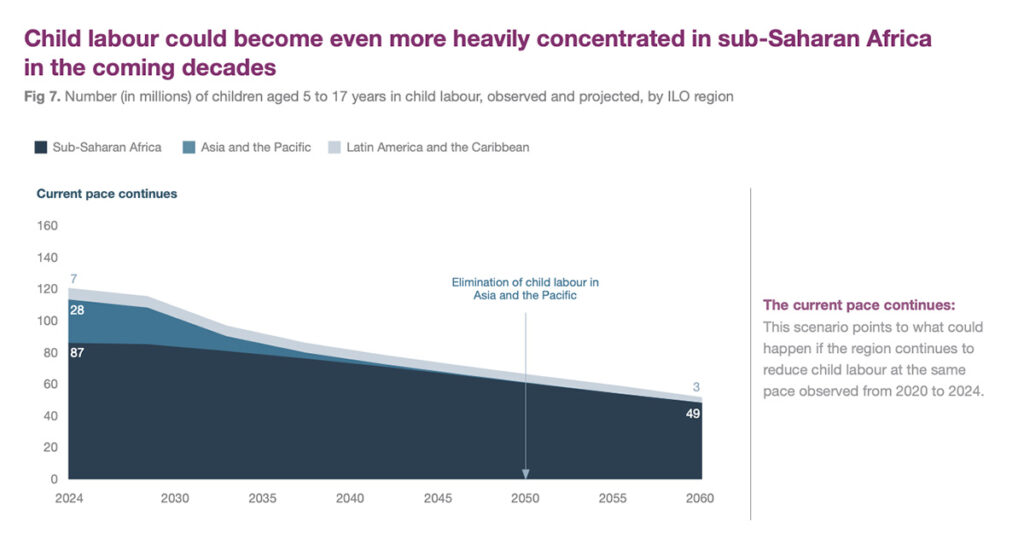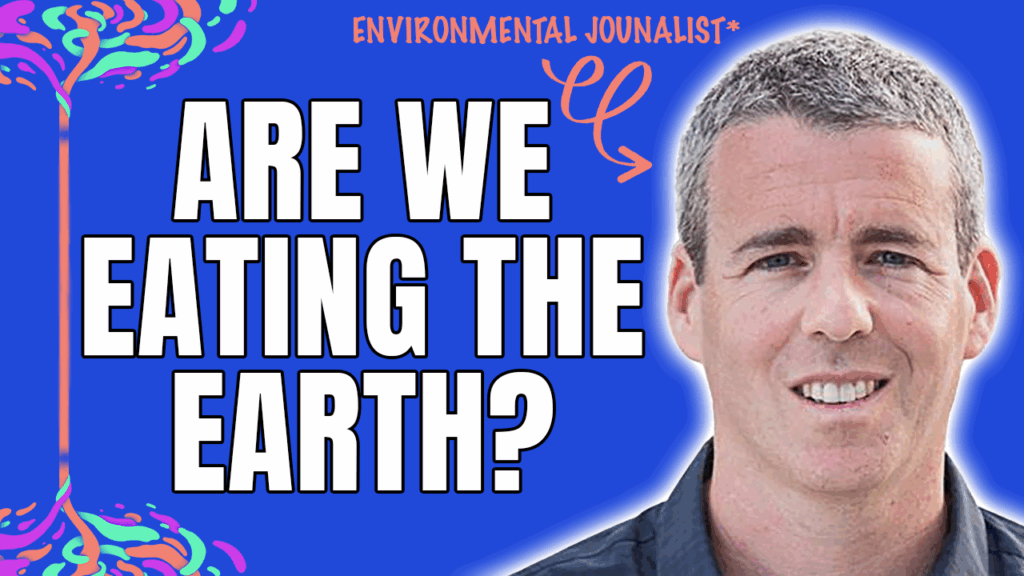Volcanoes are erupting in The Philippines, but on-fire Australia received some welcome rain. The Iran war cries have been called off and The Donald’s military powers are about to be hamstrung by the Senate. Meanwhile, his impeachment trial is starting, and we’re all on Twitter for a front-row seat.
What Could Go Right? 20 Million Fewer Children in Child Labor
In many places, child labor could disappear completely in a few decades.
This is our weekly newsletter, What Could Go Right? Sign up here to receive it in your inbox every Thursday at 5am ET. You can read past issues here.
20 Million Fewer Children in Child Labor

There are more than 20 million fewer children in child labor today than in 2020.

However long it just took you to scroll to the bottom of that block, you would have to repeat over 15,000 times to see 20 million children represented.
This reduction is especially welcome news given that so many development trends, including child labor, stalled or reversed during the pandemic. Experts weren’t sure if or how quickly the world would get back on track.
Here is the even better news: since 2000, there are 108 million fewer children in child labor, even as more and more children were born during that same time period.
To be clear, the child labor I am talking about isn’t your teenager pulling some shifts at the local ice cream shop. These are kids as young as five in poor countries who are out breaking rocks or working the fields when they should be in school.
Per a joint report by UNICEF and the International Labour Organization, since 2020, progress has occurred across all global regions and also included a substantial dip in hazardous work, defined as work that is likely to compromise a child’s health, safety, or morals.

The global goal was to end child labor by this year. With 138 million children still engaged in it worldwide, we are clearly far from success. But, the report says, “most regions could see the near or total elimination of child labor in the coming decades,” with the exception of Sub-Saharan Africa, where birth rates remain high, conflict rife, and economic growth slow. Sub-Saharan Africa is also the only region where incidence—how many children are working as compared to the total population of children—has lowered, but the number of children working has actually increased.

What is behind the downturn in child labor? One big factor is that old, familiar song of economic growth—parents who aren’t cash strapped don’t need an extra pair of hands. A second is better access to schooling, and a third, social protections for children like healthcare and cash transfers.
P.S. h/t to Progress Network member Rutger Bregman’s new book, Moral Ambition, for the data visualization idea! Check it out for inspiration on how you can be involved in driving progress forward.
Correction: Last week’s edition linked to an article that identified Ireland as the 6th European country to exit coal. It is the 15th.
What Could Go Right? S7 E17: Climate Change’s Agriculture Problem with Michael Grunwald

Can we feed the world without destroying it? Zachary and Emma speak with Michael Grunwald, award-winning journalist and author known for his work on the environment and national politics. He is currently a senior writer for Politico Magazine and author of We Are Eating the Earth: The Race to Fix Our Food System and Save Our Climate. Michael discusses ways to farm using fewer acres of land, the improvements in plant-based products, and technology innovations including gene-edited crops and lab-grown meat. He points to recent growth in energy with solar panels and electric cars, hoping that farming could have a similar revolution. | Listen now
By the Numbers
80%: The drop in homicide rates in Italy since 1990.
46: The number of countries free of malaria, now that Suriname has been certified. It is the first country in the Amazon region to eliminate the disease.
92%: The share of the world’s population with access to electricity, up from 87% in 2010.
>90: The percent of new energy capacity built worldwide in 2024 that was clean. Including nuclear, around 40% of the world’s electricity now comes from carbon-free sources.
Quick Hits
📉 The US’ infamously large prison population, which reached its peak of 1.6 million incarcerated Americans in 2009, has already fallen to 1.2 million and is on track to fall further to about 600,000. The key was a stunning drop-off in youth incarceration, which ended the cycling of former prisoners in and out of the system.
🔋 This week in renewable energy, Europe’s largest floating solar farm is now operational in France, the United Kingdom’s government thinks that their 2050 net-zero targets could be met as long as “steps forward” are taken, and CATL, the world’s largest maker of electric vehicle batteries, is trying to bring its battery-swapping and recycling technology to Europe.
⚡ It’s not just the White House eyeing a “nuclear renaissance”—a nuclear reactor building boom is underway in Europe and in countries like Vietnam and Egypt as the world eyes fast, clean electricity and the EU looks to wean itself off of Russian energy.
🔬 Artificial intelligence has allowed for the speedy identification of viable sperm in a patient with an extremely low sperm count, a process that takes humans hours or days and is often unsuccessful. Whether this could work at a larger scale remains to be determined.
🫀 American surgeons in Texas have performed the first fully robotic heart transplant, which avoids opening the patient’s chest, in the US. They follow the success of a medical team in Saudi Arabia, the first to achieve the surgery, in 2024.
🚘 An impressive 70 percent of all new passenger vehicles sold in Nepal are now electric. The small Himalayan nation, only half of whose population had access to electricity two decades ago, is now rapidly electrifying its economy.
💉 The past three years or so have seen an unprecedented scale-up of cervical cancer vaccine introductions and expanded access, particularly in Africa. The Gavi Alliance is on track to vaccinate 86 million girls with the HPV vaccine by the end of this year, “a milestone that is expected to prevent more than 1.4 million future cervical cancer deaths.”
🍔 American kids, teens, and adults are all consuming less junk food as a part of their diet than they were a decade ago, according to new data from the Centers for Disease Control. Meanwhile, millennials and Gen Z are pushing their way into a politics they see as gerontocratic.
👀 What we’re watching: Denmark is pioneering a novel legal response to the efflorescence of AI-generated deepfakes: giving everyone the copyright to their own body, face, and voice.
TPN Member Originals
(Who are our Members? Get to know them.)
- Fact vs. freakout on the SCOTUS universal injunctions ruling | Tangle | Isaac Saul
- Blockbuster Supreme Court decisions | The Preamble | Sharon McMahon
- Is China unfairly (dis)favored at the World Bank? | CGD | Charles Kenny
- Japan’s birth rates prove a baby bust doesn’t have to be a crisis | WaPo ($) | James Pethokoukis
- Did bombing Iran make America safer? | Middle East Uncovered | Faisal Saeed Al Mutar
- Iran’s nuclear aims won’t end because of airstrikes alone | WaPo ($) | Fareed Zakaria
- I detest Netanyahu, but on some things he’s actually right | NYT ($) | David Brooks
- What true political leadership looks like | Slow Boring | Matthew Yglesias
- The ultimate career advice: Make your work your calling | The Atlantic ($) | Arthur C. Brooks
- The problem-solving animal, part 3 | The Roots of Progress | Jason Crawford
- Young men have pretty positive views on manhood | Of Boys and Men | Richard V. Reeves
- Trump’s Putin pivot | Diane Francis | Diane Francis
- Reasons for optimism? | The Aspen Institute | Zachary Karabell


